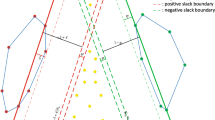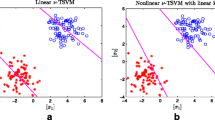Abstract
In this paper, we propose a novel classifier termed as twin-parametric margin support vector machine with truncated pinball loss (TPin-TSVM), which is motivated by the twin-parametric margin support vector machine (TPMSVM). The proposed TPin-TSVM has the following characteristics. Firstly, it can preserve both sparsity and feature noise insensitivity simultaneously, because it deals with the quantile distance which makes it less sensitive to noises, and most of the correctly classified samples are given equal penalties which makes it have the precious sparsity. Secondly, it is a non-differentiable non-convex optimization problem, we adopt the popular and effective concave–convex procedure (CCCP) to solve it. In each iteration of CCCP, the TPMSVM is utilized as a core of our TPin-TSVM, because it determines two nonparallel hyperplanes by solving two smaller sized quadratic programming problems, which greatly improves the computational speed. Thirdly, we investigate its theoretical properties of noise insensitivity and sparsity, and the proposed TPin-TSVM realizes the between-class distance maximization, within-class scatter and misclassification error minimization together. The experiments on two artificial datasets also verify the properties. We perform numerical experiments on thirty-five benchmark datasets to investigate the validity of our proposed algorithm. Experimental results indicate that our algorithm yields the comparable generalization performance compared with three state-of-the-art algorithms.








Similar content being viewed by others
References
Vapnik V (1995) The nature of statistical learning theory. Springer, New York
Sharan RV, Moir TJ (2015) Noise robust audio surveillance using reduced spectrogram image feature and one-against-all SVM. Neurocomputing 158:90–99
Nayak RK, Mishra D, Rath AK (2019) An optimized SVM-k-NN currency exchange forecasting model for Indian currency market. Neural Comput Appl 31:2995–3021
Huang X, Shi L, Suykens JAK (2014) Support vector machine classifier with pinball loss. IEEE Trans Pattern Anal Mach Intell 36:984–997
Xu Y, Yang Z, Pan X (2017) A novel twin support-vector machine with pinball loss. IEEE Trans Neural Netw Learn Syst 28:359–370
Reshma RNK, Pal A, Chandra S (2018) Generalized pinball loss SVMs. Neurocomputing 322:151–165
Tanveer M, Sharma A, Suganthan PN (2019) General twin support vector machine with pinball loss function. Inf Sci 494:311–327
Shen X, Niu L, Qi Z, Tian Y (2017) Support vector machine classifier with truncated pinball loss. Pattern Recognit 68:199–210
Yuille A, Rangarajan A (2003) The concave–convex procedure. Neural Comput 15(4):915–936
Lipp T, Boyd S (2014) Variations and extension of the convex–concave procedure. Optim Eng 1–25
Jayadeva Khemchandani R, Chandra S (2007) Twin support vector machines for pattern classification. IEEE Trans Pattern Anal Mach Intell 29:905–910
Tomar D, Agarwal S (2015) Twin support vector machine: a review from 2007 to 2014. Egypt Inform J 16(1):55–69
Kumar MA, Gopal M (2009) Least squares twin support vector machines for pattern classification. Expert Syst Appl 36:7535–7543
Khemchandani R, Saigal P, Chandra S (2016) Improvements on \(\nu\)-twin support vector machine. Neural Netw 79:97–107
Parastalooi N, Amiri A, Aliheidari P (2016) Modified twin support vector regression. Neurocomputing 211:84–97
López J, Maldonado S (2018) Robust twin support vector regression via second-order cone programming. Knowl Based Syst 152:83–93
Mello AR, Stemmer MR, Koerich AL (2020) Incremental and decremental fuzzy bounded twin support vector machine. Inf Sci 526:20–38
Richhariya B, Tanveer M (2020) A reduced universum twin support vector machine for class imbalance learning. Pattern Recognit 102:107150
Peng X (2011) TPMSVM: a novel twin parametric-margin support vector machine for pattern recognition. Pattern Recognit 44:2678–2692
Rastogi Née Khemchandani R, Saigal P, Chandra S (2018) Angle-based twin parametric-margin support vector machine for pattern classification. Knowl-Based Syst 139:64–77
Ripley BD (1996) Pattern recognition and neural networks. Cambridge University Press, Cambridge
Tomar D, Agarwal S (2015) A comparison on multi-class classification methods based on least squares twin support vector machine. Knowl-Based Syst 81:131–147
Holm S (1979) A simple sequentially rejective multiple test procedure. Scand J Stat 6(2):65–70
Demiar J, Schuurmans D (2006) Statistical comparisons of classifiers over multiple data sets. J Mach Learn Res 7(1):1–30
García S, Fernández A, Luengo J, Herrera F (2010) Advanced nonparametric tests for multiple comparisons in the design of experiments in computational intelligence and data mining: experimental analysis of power. Inf Sci 180:2044–2064
Boyd S, Parikh N, Chu E, Peleato B, Eckstein J (2010) Distributed optimization and statistical learning via the alternating direction method of multipliers. Found Trends Mach Learn 3(3):1–122
Acknowledgements
This work was supported in part by the Fundamental Research Funds for the Central Universities (No. BLX201928), National Natural Science Foundation of China (No. 11671010) and Beijing Natural Science Foundation (No. 4172035). The authors gratefully acknowledge the helpful comments and suggestions of the reviewers, which have improved the presentation.
Author information
Authors and Affiliations
Corresponding author
Ethics declarations
Conflict of Interest
The authors declare that they have no conflict of interest.
Additional information
Publisher's Note
Springer Nature remains neutral with regard to jurisdictional claims in published maps and institutional affiliations.
Rights and permissions
About this article
Cite this article
Wang, H., Xu, Y. & Zhou, Z. Twin-parametric margin support vector machine with truncated pinball loss. Neural Comput & Applic 33, 3781–3798 (2021). https://doi.org/10.1007/s00521-020-05225-7
Received:
Accepted:
Published:
Issue Date:
DOI: https://doi.org/10.1007/s00521-020-05225-7




